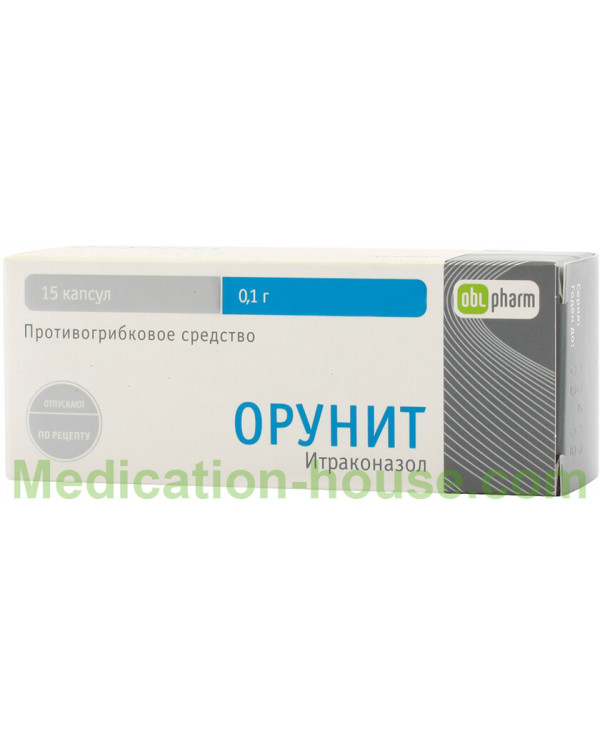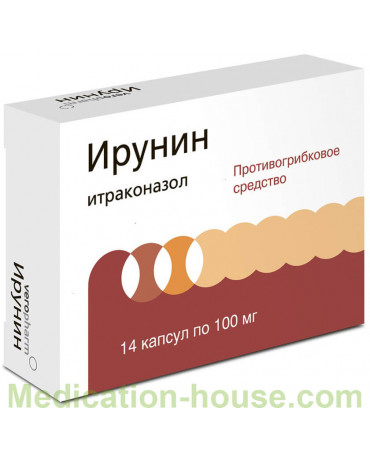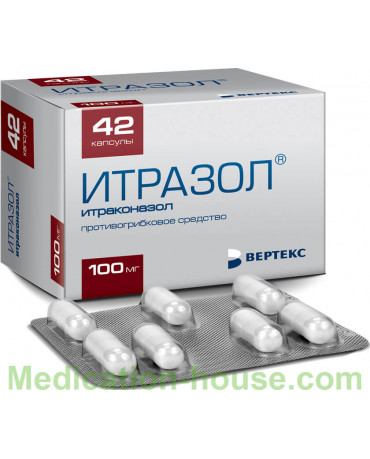Orunit instruction
You can buy Orunit here
pharmachologic effect
Antifungal broad-spectrum drug, a triazole derivative. The mechanism of action is associated with the ability of itraconazole to inhibit the synthesis of the ergosterol of the fungal cell membrane.
Active against dermatophytes (Trichophyton spp., Microsporum spp., Epidermophyton floccosum), yeast-like fungi and yeasts (Cryptococcus neoformans, Pitysporium spp., Candida spp. / Including Candida albicans, Candida glabrata and Candida krusei i Candida sbra. I Candida sic., Candida albicans, Candida sbra. Spp., Candida albicans, Candida albicans, Candida sic. ., Paracoccidioides brasiliensis, Sporothrix schenckii, Fonsecaea spp., Cladosporium spp., Blastomyces dermatitidis.
Pharmacokinetics
Suction
In oral administration, the maximum bioavailability of itraconazole is observed when taking capsules immediately after a dense meal. Cmax in plasma is reached within 3-4 hours after ingestion.
Distribution
With long-term administration of Css in plasma is achieved within 1-2 weeks and is 3-4 h after administration of the drug 0.4 μg / ml (when taking 100 mg 1 time / day), 1.1 μg / ml (when taking 200 mg 1 time / day) and 2 µg / ml (when receiving 200 mg 2 times / day). Plasma protein binding - 99.8%. The accumulation of the drug in keratin tissues, especially in the skin, is about 4 times the accumulation in plasma, and its rate of excretion depends on the regeneration of the epidermis.
Unlike plasma concentrations that cannot be detected as early as 7 days after stopping therapy, therapeutic concentrations in the skin persist for 2-4 weeks after stopping a 4-week course of treatment. Itraconazole is detected in the keratin of the nails as early as 1 week after the start of treatment and persists for at least 6 months. after completing a 3-month course of therapy. Itraconazole is also defined in sebum and to a lesser extent in perspiration.
Itraconazole is well distributed in tissues that are susceptible to fungal infections. Concentrations in the lungs, kidneys, liver, bones, stomach, spleen and muscles were 2-3 times higher than the corresponding concentrations in plasma. Therapeutic concentrations in the tissues of the vagina remain for 2 days after the end of the 3-day course of treatment at a dose of 200 mg / day and 3 days after the end of the one-day course of treatment at a dose of 200 mg 2 times / day.
Metabolism
Itraconazole is biotransformed in the liver with the formation of a large number of metabolites, one of which is hydroxy-itraconazole has an in vitro antifungal effect comparable to itraconazole.
Removal
Removal from plasma is biphasic with T1 / 2 in the terminal phase (β-phase) from 24 to 36 hours. From 3 to 18% of the dose is eliminated through the intestine. Approximately 35% of the dose is excreted as metabolites in the urine within 1 week.
Pharmacokinetics in special clinical situations
In case of abnormal liver function, it should be taken into account that itraconazole is biotransformed mainly in the liver. In patients with cirrhosis T1 / 2 is slightly increased, the bioavailability of Orunit is somewhat reduced.
In patients with renal insufficiency, the bioavailability of Orunit may be reduced.
Orunit: DOSAGE
For optimal absorption of the drug Orunit must be taken immediately after a meal. Capsules should be swallowed whole.
The oral bioavailability of itraconazole can be reduced in some immunocompromised patients, such as neutropenic patients, AIDS patients, or transplanted organs. Therefore, a double dose increase may be required.
When onychomycosis apply pulse therapy. One course of pulse therapy consists in taking 2 capsules daily. Orunit 2 times / day (200 mg 2 times / day) for 7 days.
For the treatment of fungal infections of the nail plate brushes 2 courses are recommended. For the treatment of fungal infections of the nail plate foot, 3 courses are recommended (see table). The interval between courses, during which you do not need to take the drug, is 3 weeks.
Clinical results will become apparent after the end of treatment, as nails grow back.
With onychomycosis, it is also possible to conduct continuous therapy with 2 caps. per day (200 mg 1 time / day) for 3 months.
Removal of itraconazole from the skin and nail plates is slower than from plasma. Thus, the optimal clinical and mycological effects of Orunit are achieved 2-4 weeks after the end of treatment for skin infections and 6-9 months after the end of the treatment of nail infections.
In systemic mycoses, the recommended dosages vary depending on the type of infection.
Indication
Dose
Duration
Vulvovaginal candidiasis
200 mg 2 times / day
1 day
200 mg 1 time / day
3 days
Pityriasis versicolor
200 mg 1 time / day
7 days
Dermatomycosis smooth skin
200 mg 1 time / day
7 days
100 mg 1 time / day
15 days
Fungal keratitis
200 mg 1 time / day
21 day
Lesions of highly keratinized areas of the skin, such as hands and feet, require additional treatment for 15 days at 100 mg / day. Oral cavity candidiasis.
100 mg 1 time / day
15 days
Localization of onychomycosis
1st week
2nd, 3rd, 4th week.
5th week
6th, 7th, 8th week
9th week
Damage to the nail plate of the foot with or without damage to the nail plate of the hands
1st year
course interval
2nd year
course interval
3rd year
The defeat of the nail plate brushes
1st year
course interval
2nd year
-
-
Indication
Dose
Average duration
Notes
Aspergillosis
200 mg 1 time / day
2-5 months
increase the dose to 200 mg 2 times / day in the case of an invasive or disseminated disease
Candidiasis
100-200 mg 1 time / day
from 3 weeks to 7 months
Cryptococcosis (except meningitis)
200 mg 1 time / day
from 2 months to 1 year
Cryptococcal meningitis
200 mg 2 times / day
from 2 months to 1 year
maintenance therapy (cases of meningitis) 200 mg 1 time / day
Histoplasmosis
from 200 mg 1 time / day to 200 mg 2 times / day
8 months
-
Sporotrichosis
100 mg 1 time / day
3 months
-
Paracoccidioidomycosis
100 mg 1 time / day
6 months
-
Chromomycosis
100-200 mg 1 time / day
6 months
-
Blastomycosis
from 100 mg 1 time / day to 200 mg 2 times / day
6 months
-
Overdose
To date, cases of drug overdose Orunit not described.
Treatment: in case of accidental overdose during the first hour after taking Orunit, it is necessary to do a gastric lavage, if necessary, to appoint activated charcoal. Symptomatic and maintenance therapy is indicated. Itraconazole is not excreted through hemodialysis. The specific antidote is not known.
Drug interactions
Not recommended simultaneous use of rifampicin, rifabutin and phenytoin (strong inducers of microsomal liver enzymes), because these drugs may decrease plasma concentration of itraconazole. Studies on the interaction of itraconazole with other inducers of hepatic enzymes, such as carbamazepine, phenobarbital and isoniazid, have not been conducted, but a similar effect can be expected.
Because Itraconazole is mainly metabolized with the participation of CYP3A4 isoenzyme cytochrome P450, strong inhibitors of this enzyme (including ritonavir, indinavir, clarithromycin and erythromycin) can increase the bioavailability of itraconazole.
Itraconazole can inhibit the metabolism of drugs that are biotransformed with the participation of the CYP3A4 isoenzyme. The result may be an increase or prolongation of their action (including side effects). During the course of treatment with itraconazole, it is impossible to use drugs that are metabolized by CYP3A4 isoenzyme (terfenadine, astemizole, mizolastine, cisapride, triazolam, midazolam, dofetilide, quinidine, pimozide), HMG-CoA reductase inhibitors (simvastatin and catastrose, and simvastatin and catastrose).
Calcium channel blockers have a negative inotropic effect, which can enhance the similar effect of itraconazole; Itraconazole can reduce the metabolism of calcium channel blockers (the use of this combination requires caution).
Drugs that, if taken simultaneously with itraconazole, require control of their concentrations in the blood plasma and, if necessary, dose reduction: oral anticoagulants; HIV protease inhibitors (ritonavir, indinavir, saquinavir); some anticancer drugs (Vinca pink alkaloids, busulfan, docetaxel, trimetrexate); calcium channel blockers, metabolized with the participation of the isoenzyme CYP3A4 (dihydropyridine and verapamil); some immunosuppressants (cyclosporine, tacrolimus, sirolimus); other drugs - digoxin, carbamazepine, buspirone, alfentanil, alprazolam, brotizolam, rifabutin, methylprednisolone, ebastine, reboxetine.
No interaction between itraconazole and zidovudine and fluvastatin was detected. No effect of itraconazole on the metabolism of ethinyl estradiol and norethisterone was noted.
In vitro studies have shown no competition between itraconazole and drugs such as imipramine, propranolol, diazepam, cimetidine, indomethacin, tolbutamide, and sulfamethazine for binding to plasma proteins.
Pregnancy and lactation
Based on the results of preclinical studies and due to the fact that studies on the use of itraconazole in pregnant women have not been conducted, itraconazole should be prescribed to pregnant women only with life-threatening systemic mycosis, when the potential benefit to the woman justifies the possible risk to the fetus.
Because a small amount of itraconazole is excreted in breast milk, the expected benefits of taking itraconazole must be compared with the risk for the baby when breastfeeding. In case of doubt, breastfeeding should be canceled.
Orunit: ADVERSE EFFECTS
On the part of the digestive system: possible - dyspepsia, nausea, abdominal pain, constipation, a reversible increase in the activity of liver enzymes; in some cases with prolonged treatment - cholestatic jaundice, hepatitis; very rarely - severe toxic liver damage (including cases of acute liver failure with a fatal outcome).
On the part of the central nervous system and peripheral nervous system: in some cases - headache, fatigue, dizziness, peripheral neuropathy.
On the part of the reproductive system: in some cases with prolonged treatment - menstrual disorders.
On the part of the urinary system: hypercreatininemia, urine staining in a dark color.
Metabolism: edema, hypokalemia.
Since the cardiovascular system: possible congestive heart failure, edema, pulmonary edema.
Allergic reactions: itching, rash, urticaria, angioedema, Stevens-Johnson syndrome.
Other: with long-term use - alopecia, hypokalemia.
Terms and conditions of storage
Orunit should be stored in a dry, dark place, out of reach of children at a temperature not higher than 25 ° C. Shelf life - 2 years.
Indications for Orunit
dermatomycosis;
fungal keratitis;
onychomycosis,
caused by dermatophytes and / or yeasts and molds;
systemic mycoses: systemic aspergillosis and candidiasis,
cryptococcosis (including cryptococcal meningitis),
histoplasmosis,
sporotrichosis
paracoccidioidomycosis,
blastomycosis and other systemic or tropical mycoses;
Candidomycosis with damage to the skin or mucous membranes (including
vulvovaginal candidiasis);
deep visceral candidiasis;
pityriasis versicolor.
Contraindications for Orunit
simultaneous use of terfenadine
astemizole,
Mizolastina,
cisapride
dofetilide,
quinidine
pimozide (metabolized by the enzyme CYP3A4),
triazolam,
midazolam
HMG-CoA reductase inhibitors (simvastatin,
lovastatin);
hypersensitivity to the drug.
In pregnancy, Orunit is prescribed only in cases where the expected benefit of therapy for the mother outweighs the potential risk to the fetus.
With caution prescribed in childhood, with severe heart failure, liver diseases (including those accompanied by liver failure).
special instructions
Itraconazole has a negative inotropic effect. It was reported about cases of development of heart failure associated with taking Orunit, in connection with which Orunit should not be prescribed to patients with chronic heart failure (or with an indication of this disease in history), except in cases where the potential benefits of such therapy far exceeds the potential risk. . In an individual assessment of the balance between benefits and risks, factors such as the seriousness of the indications, the dosing regimen and individual risk factors for heart failure should be taken into account. Risk factors include heart disease (such as IHD or valvular lesions), serious lung diseases (such as obstructive pulmonary lesions), renal failure, or other diseases associated with edema. Patients need to be informed about the signs and symptoms of heart failure. Treatment should be carried out with caution, while it is necessary to monitor the patient for signs of congestive heart failure. When they appear, Orunit should be discontinued.
Calcium channel blockers (verapamil) may have a negative inotropic effect, which may enhance the similar effect of itraconazole; Itraconazole can reduce the metabolism of calcium channel blockers. At the same time taking itraconazole and calcium channel blockers should be careful.
At low acidity of gastric contents, the absorption of itraconazole is impaired. Patients taking antacid preparations (for example, aluminum hydroxide) are recommended to use them no earlier than 2 hours after taking Orunit capsules. Patients with achlorhydria or when using histamine H2-receptor blockers or proton pump inhibitors are recommended to take Ornith capsules with acidic drinks.
In very rare cases, the use of itraconazole developed severe toxic liver damage (including cases of acute liver failure with a fatal outcome), in most cases in patients with existing liver diseases, or receiving systemic treatment for other indications, or other serious medical conditions. , as well as in combination therapy with drugs with hepatotoxic properties. Some patients did not identify obvious risk factors for liver damage. Several such cases occurred in the first month of therapy, and some in the first week of treatment. In this regard, it is recommended to regularly monitor liver function in patients receiving itraconazole therapy. Patients should be warned about the need to immediately consult a doctor in case of symptoms that suggest the development of hepatitis, namely: anorexia, nausea, vomiting, weakness, abdominal pain and darkening of the urine. In the event of such symptoms, you must stop taking the drug and conduct a study of liver function. Patients with elevated liver enzymes, or liver disease in the active phase, or when toxic liver damage is tolerated while taking other drugs should not be prescribed Orunit treatment, unless the expected benefit justifies the risk of liver damage. In these cases, it is necessary to monitor the activity of hepatic enzymes during treatment.
With the duration of the reception Orunit more than 1 month is necessary to monitor liver function.
In patients with cirrhosis of the liver, dosage adjustment may be required.
In patients with renal insufficiency, dosage adjustment may be required.
Treatment should be discontinued if neuropathy occurs, which may be associated with Orunit.
There is no evidence of cross-hypersensitivity to itraconazole and other azole antifungal agents. Orunit should be used with caution in patients with hypersensitivity to other azoles.
In patients with impaired immunity (AIDS, after organ transplantation, neutropenia), an increase in the dose of Orunit may be necessary.
Use in pediatrics
Clinical data on the use of itraconazole in children is insufficient, and therefore Orunit should be prescribed only if the expected benefit outweighs the possible risk.
Terms of sell
You can buy Orunit without a prescription.




